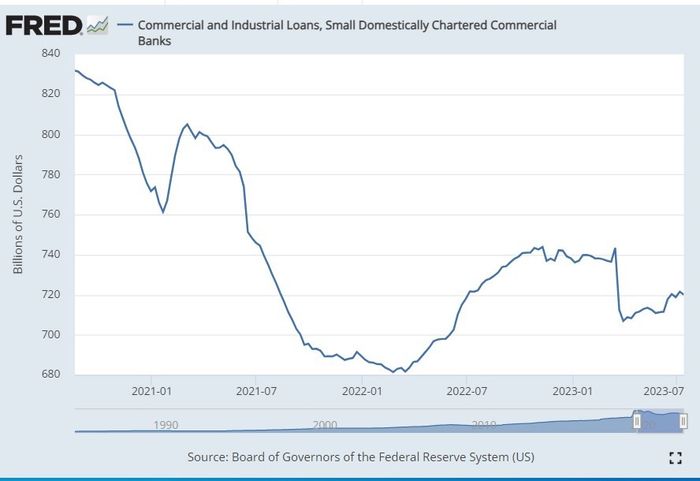 Looking to get involved with a platform that can change the face of decentralized finance forever? Xuirin Finance is revolutionizing the DeFi landscape through its innovative offerings like KYC-free debit cards, P2P lending, and so much more. Supporters can take part in the first stage of its presale right now. Xuirin Finance to Offer Futuristic […]
Looking to get involved with a platform that can change the face of decentralized finance forever? Xuirin Finance is revolutionizing the DeFi landscape through its innovative offerings like KYC-free debit cards, P2P lending, and so much more. Supporters can take part in the first stage of its presale right now. Xuirin Finance to Offer Futuristic […]
Source link
lending
This fintech startup is targeting a gap in lending as banks tighten credit

With banks facing higher interest rates that bite into economic activity, not to mention their need to stockpile money for bad debts or unpaid credit-card bills, it has been harder to get a loan in the past year or so.
At least one startup sees an opportunity.
The founders of financial-technology company Nectar told MarketWatch this year’s market conditions are fueling its growth at a time when banks remain more selective with their loans.
“It’s a good time to be in this business because access to capital has dried up,” said Derrick Barker, 36, who co-founded Nectar with his wife, Brittany Mosely, 35.
Also read: New York Community Bancorp led increase in loan-loss reserves by big regional banks as lenders brace for potential downturn
With 92 loan deals and counting since its launch in 2021, Nectar now employs 12 people as a lender to real-estate investors and owners who often build housing for Black Americans and other people of color.
It’s worked on more than $500 million in transactions including apartments, multi-family buildings, single-family rentals, hospitality properties, assisted living facilities and commercial real estate.
Nectar’s success thus far illustrates the alternative ways capital is being provided to individuals and businesses even as banks grow more conservative.
The growth of private credit has pivoted to meet some of this demand, but fintechs such as Nectar are also ramping up.
To be sure, others offer quicker routes to capital than many banks. Capchase Inc., for example, specializes in loans based on annual recurring revenue for software-as-a-service companies in the business-to-business space.
Pipe Technologies Inc. operates a trading platform to connect institutional investors and companies with recurring revenue streams to get financing for growth.
For its part, Nectar saw revenue growth of 750% between 2022 and 2023 by focusing on an underserved part of the market, namely people with $50 million to $500 million in assets, typically in real estate.
“The supply chain for capital is … old, outdated and broken, specifically for people who aren’t large institutions,” Barker told MarketWatch. “We want to fix that. We can provide to those people who are medium-size and smaller who are making an impact with the capital they need, so they can build the housing that needs to be built.”
Nectar’s mezzanine debt deals focus on transactions of less than $5 million, much smaller than the $20 million cutoff from many major banks. The company uses existing assets and cash flow generated by rent and other payments as collateral for the loan. This structure allows real-estate owners to retain more of the equity in their own property than other types of financing.
“We can come in and look at their stabilized cash flow and their properties so they can keep doing the important work that they’re doing, which is creating affordable housing … across the country,” Barker said.
Barker and Mosely met while studying at Harvard University, got married in 2015 and went into different careers. She headed for the retail sector, while Barker worked as a bond trader for Goldman Sachs Group Inc.
GS,
During and after his time at Goldman Sachs, Barker built up his own $450 million real-estate portfolio by buying abandoned apartments and rehabilitating them.
Barker started working to solve the challenge of coming up with working capital and liquidity for real-estate properties with low leverage and positive cash flow, which is the core business of Nectar.
For her part, Mosely had seen property owners giving up equity to investors — the limited partners, or LPs, in a real-estate private-equity fund — to get capital.
“For me, it was about really being on the front lines and doing all the work that it took to acquire the property and actually manage the construction or the rehab and when it came time to sell, the LPs would take most of the profit,” Mosely said. “I felt there had to be a better way to grow without property owners having to give up equity — that was my drive to co-found Nectar.”
Many of Nectar’s lending deals are sub-institutional, and many of them are for housing.
These so-called Class C properties — defined as 30 years old, in fair to poor condition, and in less-desirable locations compared with Class A or Class B buildings — often house a greater proportion of Black Americans and people of color.
“They’re still the places where Black people live. If you look at the Class C apartments, they’re the apartments that more people of color are more likely to live in,” Barker said. “They’re also more likely to be owned
by smaller institutions with less access to [loans]. By providing access to capital, it helps … people who are creating housing for this part of the population.”
Nectar remains well capitalized after lining up venture-capital backing from RareBreed Ventures, J4 Ventures and Asymmetry Ventures. Nectar is also raising a private-equity real-estate fund to generate capital for deals called Nectar Fund 2, which has a $100 million target.
Nectar is able to approve financing in as little as seven days, once all underwriting due diligence has been handed in.
Nowadays, Nectar’s portfolio has a combined leverage below 60%. The company maintains more than 2x coverage for every $1 that’s borrowed.
“We do some detailed and deep underwriting. We get to focus on the cream of the crop,” Barker said. “Just because the loans are smaller doesn’t mean they’re not good.”
Also read: Why small-business loans are a win-win for women-run startups and smaller banks
BlockFi CEO Zac Prince testifies to lending relationship with Alameda Research before its collapse

Zac Prince, the CEO of BlockFi, continued to provide testimony in the criminal trial of former FTX CEO Sam Bankman-Fried on Oct. 13.
In the previous day’s testimony, Prince described his firm’s lending relationship with Alameda Research. In current testimony, he described how Alameda began to dominate BlockFi lending activities and noted that he spoke to FTX and Alameda as loans grew larger.
Prosecutors: “Did you talk with Sam Bankman-Fried?”
Prince: “Yes, a CEO to CEO was suggested. So we did a call.”
Prince said that BlockFi had at one point lent out $5 billion to $10 billion to its clients overall. Alameda Research had initially borrowed $10 million circa early 2021, but that amount eventually rose to $50 million in May 2021 and to $1.1 billion in May 2022.
The BlockFi executive noted that his firm was also affected by other industry events, including the collapse of Luna and TerraUSD (which was followed by Three Arrows Capital’s default on its loan to BlockFi) as well as the bankruptcy of Celsius and Voyager.
Prince said that BlockFi, at one point, attempted to have FTX acquire it, as reported in mid-2022. Though the acquisition never occurred, Prince admitted that the arrangement with FTX influenced BlockFi’s decision to lend money to Alameda as a “data point.” He did not admit that BlockFi loaned to Alameda wholly because of that arrangement.
BlockFi was unaware of FTX’s wrongdoing
Prosecutors then presented Prince with Alameda’s Q2 2022 balance sheet. Though Prince was familiar with it, he said that he was told the loans detailed on the sheet were from other crypto lenders, as opposed to loans between FTX and Alameda.
Prince said that if he had known of FTX’s multibillion-dollar loans to Alameda, BlockFi would not have lent money to Alameda as it “would have been insolvent.” He added that if he had known that Alameda was using money that belonged to FTX customers, BlockFi would not have lent money as that practice is “not appropriate.”
Furthermore, Prince said that if he had known of Alameda’s loans to Sam Bankman-Fried, BlockFi would have been “concerned.” Early bankruptcy reports suggest that Bankman-Fried personally borrowed at least $1 billion from Alameda.
Prince also testified that when the price of FTX’s FTT token fell around the time of the companies’ collapses, BlockFi attempted to call certain loans.
Prince said that, at the time of the collapse, $650 million of loaned funds were still outstanding and said that BlockFi had $350 million on FTX, leaving $1.1 billion affected. He testified that Alameda and FTX led to BlockFi’s own bankruptcy.
Cross-examination addresses finer points
During cross-examination, Bankman-Fried’s lawyer seemingly attempted to draw attention to the fact that both BlockFi and FTX lent out customer assets. Prince emphasized that BlockFi lent customer funds “if they agreed to.”
Also during that period, Cohen asked Prince whether BlockFi’s team had advised against increasing exposure to FTT tokens. Prince replied that the entire team had not advised this and said that BlockFi had made more loans when it required more collateral.
Earlier, Prince had noted BlockFi had received Grayscale Trust and Robinhood shares as collateral. Cohen asked whether Prince was aware of who owned those Robinhood shares. Prince replied that he “wasn’t aware of the nuances.” Robinhood recently purchased those shares from the U.S. government after they were seized from Bankman-Fried. In late 2022, BlockFi had attempted to lay claim to the shares itself.
Finally, Cohen asked whether Prince was ever concerned about whether BlockFi might go bankrupt. Prince answered that a CEO “must think of possibilities.”
Cohen’s cross-examination concluded at that point. The trial will continue next week, with FTX associates Nishad Singh and Ramnik Arora providing testimony.
Cryptocurrency exchange Coinbase has rolled out a crypto lending service for institutional investors in the United States, reportedly aiming to capitalize on massive failures in the crypto lending market.
Coinbase has launched an institutional-grade crypto lending platform to U.S. investors, offered as part of its existing offering Coinbase Prime, a spokesperson for Coinbase confirmed to Cointelegraph on Sept. 6.
“Coinbase is launching a digital asset lending program for its institutional Prime clients,” the representative said, adding:
“With this service, institutions can choose to lend digital assets to Coinbase under standardized terms in a product that qualifies for a Regulation D exemption.”
According to a filing with the U.S. Securities and Exchange Commission, Coinbase customers have already invested $57 million in the lending program since the first sale occurred on Aug. 28. The offering had attracted five investors as of Sept. 1.

The new product comes in line with Coinbase’s commitment to “update the financial system that was built over 100 years ago, leveraging crypto to provide people with more economic freedom and opportunity,” a spokesperson for Coinbase the noted.
The new crypto lending product by Coinbase follows the halt of new loan issuance on Coinbase Borrow in May 2023. The program is designed to allow users to receive up to $1 million through Bitcoin (BTC) collateral. The new institutional program is operated through Coinbase Credit, the same entity that manages Coinbase Borrow.
Related: SEC vs. Coinbase: New lawyer Patrick Kennedy joins fight
The news comes months after the U.S. SEC charged Coinbase with alleged offering and sale of unregistered securities in connection with its crypto starking services, which allow users to earn yields on giving their crypto to the platform. The exchange opposed the SEC’s allegations, arguing that it strongly disagreed with any allegations that its staking services were securities.
Coinbase eventually had to pause its staking program in four states — California, New Jersey, South Carolina and Wisconsin — while the proceedings were going forward.
The crypto lending industry was hit with a massive crisis last year, with major companies like BlockFi, Celsius and Genesis Global going bankrupt amid a lack of liquidity caused by the bear market of 2022. Some crypto enthusiasts said that the crypto lending sector must learn lessons from the collapses and solve issues related to short-term assets and short-term liabilities.
Collect this article as an NFT to preserve this moment in history and show your support for independent journalism in the crypto space.
Magazine: Magazine: How to protect your crypto in a volatile market — Bitcoin OGs and experts weigh in
Crypto firm Helio Lending gets bond sentence over false license claims

Australia-based crypto lender Helio Lending has been sentenced to a non-conviction good behavior bond for a year for falsely claiming it had a local credit license.
On Aug. 17, the Australian Securities and Investments Commission said Helio was sentenced to a non-conviction bond of 15,000 Australian dollars ($9,600) on condition of good behavior for a year.
Good behavior bonds are often granted for less serious offenses. A non-conviction good behavior bond means Helios will only be convicted if it breaks its bond. The AU$15,000 potential penalty is a significantly lighter sentence than the maximum $160,000 penalty it faced.
ASIC said Helio falsely stated it had an Australian credit license in an August 2019 news article that appeared on its website.
Melbourne-based cryptocurrency lender Helio Lending Pty Ltd has been sentenced to a non-conviction bond for falsely claiming that it held an Australian credit licence when it did not pic.twitter.com/gOsHHp02xL
— ASIC Media (@asicmedia) August 17, 2023
Helio pleaded guilty, which ASIC said was accounted for in the sentencing decision and a charge relating to a false representation of holding a license on Helio’s website was withdrawn.
Helio offered crypto-backed loans and is an Australian subsidiary of the United States-based crypto-focused public holding company Cyios Corporation, which also owns the yet-to-launch nonfungible token platform Randombly.
ASIC charged Helio in April 2022 over the matter. In a circulating investor update from late 2018, Helio claimed it received the license by buying out Cash Flow Investments and its held license.
Related: Australia’s Bendigo Bank blocks high-risk payments to crypto exchanges
ASIC’s latest win follows other crypto-related suits its launched in recent weeks.
Earlier in August the regulator sued the trading platform eToro alleging its screening tests before offering leveraged derivative contracts to retail investors were insufficient.
Finder.com was also sued in December, with ASIC claiming the financial product comparison site’s crypto yield-bearing product was offered without the required license.
Collect this article as an NFT to preserve this moment in history and show your support for independent journalism in the crypto space.
Magazine: Crypto City guide to Sydney — More than just a ‘token’ bridge
The numbers: Commercial and industrial lending — a key driver of economic activity — fell by $2.1 billion to $2.75 trillion in the week ending July 12, the Federal Reserve said Friday.
C&I loans hit a peak of $2.82 trillion in mid-March, right before the collapse of Silicon Valley Bank, and the pace of lending has been slowing gradually ever since.
Key details: Lending at large domestic banks rose $1.7 billion in the latest week to $1.54 trillion. Large-bank lending has held fairly steady this year. It stood at $1.55 trillion in the week of Jan. 4.
Lending at small domestic banks fell $1.5 billion to $720 billion. Small-bank lending fell sharply after Silicon Valley Bank collapsed but has recovered somewhat from a low of $706.9 billion in late March.

Uncredited
Big picture: The bank woes caused by the collapse of Silicon Valley Bank in March have added to uncertainty about the U.S. economic outlook. Former Fed Chair Ben Bernanke said the crisis “seems to be better” but that bank lending has been slowing and credit standards are tighter. This should continue to slow the economy going into next year.
Already demand for cars is softening is the face of tighter credit standards and sharply higher interest rates, said Ian Shepherdson, chief economist at Pantheon Macroeconomics.
The Fed tracks bank-lending standards by conducting quarterly surveys of bank executives.
Market reaction: Stocks finished mixed on Friday, although the Dow Jones Industrial Average
DJIA,
extending a winning streak to 10 days. The yield on the 10-year Treasury note
TMUBMUSD10Y,
rose 1.9 basis points this week.
China’s benchmark lending rates were kept unchanged, as expected on Thursday, following a hold of policy rates earlier this month. However, economists say Beijing will need to ramp up support to shore up the country’s sputtering economy.
The one-year loan prime rate was held steady at 3.55%, while the five-year LPR was unchanged at 4.2%, the People’s Bank of China said. The loan prime rates are calculated monthly based on the interest rates which 18 designated commercial banks charge their best clients.
Thursday’s move was widely expected after the central bank kept its key policy rate–the interest rates of the medium-term lending facility which banks use to price LPRs–unchanged on Monday.
Last month, China’s sluggish economic growth prompted authorities to lower a set of policy rates, which later guided down the benchmark loan rates and reduced the likelihood of near-term rate cuts.
A senior central bank official said last week that policy tools such as the reserve requirement ratio and MLF would be deployed to shore up the world’s second-largest economy, but economists say any future rate cuts risk further pressuring the yuan given the diverging monetary stance between China and the U.S., urging Beijing to deliver more fiscal support.
In a separate announcement on Thursday, the PBOC relaxed rules to allow companies to borrow more from overseas by raising its macro-prudential parameter for companies’ and financial institutions’ cross-border funding to 1.5 from 1.25, effective immediately. This could open the door to more capital inflows and aid the weakening yuan, analysts say.
Official data released Monday showed that China’s economy barely grew in the second quarter from the first quarter and youth unemployment hit a record high in June. Beijing currently faces multiple challenges from weak domestic consumption, damped business confidence, plunging exports and a protracted property slump, economists say.
So far, Beijing has disappointed the market by not handing out any form of large-scale stimulus, underscoring authorities’ limited options against the backdrop of mounting government debts. China’s Politburo, the country’s top decision-making body, is set to convene a meeting on economic affairs later this month and is expected to announce more stimulus to jump-start growth.
The outlook for DeFi lending remains strong – The industry is mature and ripe for institutions

The following is a guest post from Robert Alcorn, co-founder and CEO of Clearpool.
As we enter the mid-point of 2023, the DeFi lending market continues to grow, observing a 20.5% increase in Total Value Locked (TVL). This reflects a shared consensus among traditional and crypto-native institutions that DeFi has the potential to solve the problems that led to systemic failures across the CeFi market in 2022.
Regulation, though presenting hurdles, is further propelling the evolution of DeFi. The emergence of sophisticated protocols is moving the nascent crypto credit market to a mature DeFi ecosystem. Growing regulatory scrutiny emphasizes the need for KYC and AML-compliant protocols to enable institutional DeFi adoption.
Resilient DeFi protocols, having withstood the tests of 2022, have emerged as critical pieces of market infrastructure. For the DeFi industry to continue growing, we must focus on attracting more institutional players and creating more sophisticated products.
Institutions assess the DeFi landscape
In assessing DeFi, crypto-native institutions are, of course, more familiar with the concepts. However, both traditional and crypto-native institutions share optimism for DeFi’s potential in building a more transparent and efficient financial market infrastructure.
Even with last year’s CeFi collapses, DeFi is seeing a gradual return to growth, albeit slower than in 2022.
Nevertheless, DeFi, and the broader digital asset market in general, continue to draw institutional attention. Notable examples include:
- BlackRock’s June 2023 paperwork filing for a spot bitcoin (BTC) ETF.
- Franklin Templeton’s launch of a crypto product that tokenizes U.S. government securities, cash, and repurchase agreements on Polygon in April 2023.
- JPMorgan Chase’s continued commitment to tokenizing traditional financial assets through its Onyx digital assets platform, processing nearly $700 billion in short-term loan transactions.
- Jane Street’s first-of-its-kind loan agreement with BlockTower Capital for $25M in May 2022.
Regulatory clarity and innovation dual approach gain institutional traction
The main obstacle for traditional institutions remains; regulatory clarity and compliance. A recent report from JPMorgan (JPM) underscored this, suggesting the need for
“a comprehensive framework on how to regulate the crypto industries and the relative responsibilities of SEC vs the Commodity Futures Trading Commission (CFTC).”
Notably, significant progress has been made across Asia and the Middle East. Hong Kong’s Securities and Futures Commission (SFC) is actively adapting its policy for better cryptocurrency retail access. With establishing VARA, the inaugural standalone regulator for virtual assets, Dubai has positioned itself as a pioneer in crypto regulation.
In addition, central banks in both Hong Kong and the UAE have unveiled plans for joint efforts in crypto asset regulation, signaling their commitment to fostering a crypto-friendly environment. These advancements suggest that Asia and the Middle East will emerge as the leading crypto lending hubs as investor confidence builds.
Alongside regulatory advancements, DeFi protocols must develop innovative, sophisticated products to attract a more diverse user base. This includes fostering a secure and compliant environment for wholesale borrowing and lending of digital assets by institutions, thereby ensuring liquidity and efficient pricing to market participants.
Undoubtedly, the setbacks in 2022, primarily due to mismanagement issues within the more opaque CeFi segment, temporarily slowed institutional adoption of DeFi. However, the recent moves by large financial institutions towards DeFi is a promising sign that the industry is gaining momentum.
DeFi outperformed CeFi
Since the 2021 DeFi boom, decentralized exchanges (DEXs) trading volume has grown consistently, showing a clear shift from centralized exchanges with their opaque practices and questionable risk management.
DeFi platforms offer a unique advantage – they eliminate central points of failure. With DeFi, lenders have the autonomy to select their borrowers. Fund transfers occur directly between lender and borrower through a smart contract coded in a way that can’t be changed – there’s no central intermediary.
Rather than causing chaos, market volatility activates certain in-built mechanisms within these smart contracts. They incentivize certain behaviors from borrowers and lenders to help maintain a balanced marketplace.
Ushering in a new era of decentralized finance
DeFi’s resilience stems from its architectural design and its community of builders and stakeholders who rise to the challenges thrown at them. Their commitment to innovation and sustainable growth enables DeFi platforms to weather the storms of market volatility.
Unique mechanisms like direct transactions via unchangeable smart contracts and autonomous market responses to market upheavals reinforce this resilience. These advantages set DeFi apart from CeFi and ensure its better performance in stress tests.
The digital assets industry will become an integral part of the global economy. The traditional financial services industry will always have its place, but it will be augmented by the decentralized financial ecosystem we are building today.
DeFi is not just surviving – it’s set to thrive.
Robert Alcorn is an experienced entrepreneur with over 20 years of professional experience across global financial markets. Rob was an early adopter of Bitcoin, first venturing into crypto in 2015.
Before establishing Clearpool, Rob was the APAC Head of Repo Trading at First Abu Dhabi Bank, where he built the sales and trading desk from the ground up, into a multi-billion-dollar franchise. Alongside this role, Rob initiated and led a project to build an Automated Wealth Management Platform using blockchain technology.
During his career, Rob has held positions in Asset and Liability Management, Fixed Income / Money Market Sales, and working as a Senior Broker in Fixed Income Markets. In 2021, Rob co-founded Clearpool to solve one of the most significant problems facing DeFi borrowers – over-collateralization. Rob is a CFA Charterholder and holder of the Massachusetts Institute of Technology’s Fintech Certificate in Future Commerce.
Fintech lenders are not living up to their hype of revolutionizing lending
For years, the financial technology industry has touted its ability to spot good credit risks missed by big banks and traditional lenders, providing people with affordable loans they might not otherwise be able to access.
The technology companies and startups that make up the fintech world “rely heavily” on credit scores to price their loans and don’t incorporate other variables that could better predict default, according to a working paper distributed by the National Bureau of Economic Research earlier this year. As a result, fintech clients and customers with nonprime credit scores pay interest rates that are 45% more expensive than prime borrowers who are similarly at risk of default, the paper found.
“If you believe that fintech is this really sophisticated machine that is able to identify risk better than traditional lenders, the surprising outcome of this paper” is that “it looks like it still has a ways to go to really price things according to risk,” said Mark Johnson an assistant professor of finance at Brigham Young University’s Marriott School of Business and one of the authors of the paper.
For decades, lenders have relied on credit scores from companies like FICO to evaluate the risk that a borrower will default. Recently, those formulas have faced criticism from consumer advocates and lawmakers who say they use variables that bake in discrimination. As a result, these credit scores aren’t an accurate predictor of borrowers’ risk and are particularly faulty when it comes to low-income borrowers and borrowers of color, critics argue. Fintech lenders have said that by using the power of artificial intelligence and other tools to suck in a wide swath of data, they can find borrowers with bad credit scores who are actually good credit risks and lend to them accordingly.
While these lenders may be using their models to provide credit to borrowers who historically have been considered too risky for traditional lenders, what Johnson’s paper suggests is that these borrowers are paying more for it than those who are similarly risky. These borrowers, who are paying $500 more on average in the first year of their loan, according to the paper, are more likely to be those with the least room in their budget to absorb the extra cost, said Matthew Bruckner, an associate professor of law at Howard University School of Law.
“For low-income borrowers there is often a narrative around they’re higher risk, they are less likely to repay, they’re more financially marginal,” Bruckner said. The paper challenges that narrative, he said. “The loans themselves are what create the defaults,” he said. “If you’re being charged 10% instead of 4%, the payments are higher and it’s just harder to make them,” he added.
‘A lot of mirror and smoke’
To understand how fintech companies are pricing their loans, Johnson and his co-authors analyzed aggregate loan data that covers about 70% of the fintech personal-loan market. The names of the companies weren’t included in the dataset. Some of the leading fintech personal loan originators include SoFi
SOFI,
Lending Club
LC,
Upstart
UPST,
and Prosper, according to S&P Global Market Intelligence.
The paper’s authors, which include economists from the Securities and Exchange Commission, Georgia State University and Ohio State University, weren’t initially looking to the data to get a sense of fintech loan pricing, Johnson said. Instead, they wanted to know how sports gambling affected people’s use of debt. But what stuck out in their review of the data they obtained was that borrowers faced a large jump in interest rates when their credit score went even slightly below the 660 threshold, the cutoff for what’s considered a prime credit score.
“That was a striking fact,” Johnson said. “You can imagine that people who have FICO scores of 659 are identical in terms of risk to people who have FICO 660.”
That indicates that despite claims from fintech lenders that they harness information outside of traditional credit scoring to price loans, the “pricing still looks relatively unsophisticated,” Johnson said. The authors of the paper were able to determine that the fintech lenders’ pricing isn’t directly related to the risk a borrower will fall into delinquency or default by developing their own algorithm, which determined what interest rate a lender should charge a borrower if they were going to get a 5% return on the loan.
What they found is that borrowers who are less risky, but have nonprime credit scores are overpaying for their debt and subsidizing riskier borrowers with prime credit scores. The authors speculate that there are two reasons why the loans in the data set aren’t being priced according to risk. The first is a lack of competition for borrowers with credit scores below 660. Because traditional lenders typically don’t work with this population, fintech lenders have more room to raise rates for this group.
The other has to do with fintech lenders’ business model. These companies typically make loans and then sell them. Because banks won’t buy loans made to borrowers with credit scores below 660, due to regulation, fintech lenders have to look to other institutions to buy these loans.
“The hedge funds or other investors that take below 660 loans require higher returns so they have to charge higher interest rates,” Johnson said. “Interest rates don’t seem to be determined by risk, they seem to be determined, at least in part, by market forces that are outside of fintech’s modeling.”
Marco Di Maggio, director of the Fintech Lab at Harvard Business School, said Johson’s paper indicates that in many cases fintech lenders’ promise to bring traditionally underserved people into the financial system is “a lot of mirror and smoke.” Instead, these companies are actually engaging in “a little bit of regulatory arbitrage,” Di Maggio said.
“We can get funding from the banks and do riskier loans, securitize these loans and sell them to investors,” Di Maggio said of the system many fintech lenders use. “Everybody in the current system is using these new companies as a way of creating some value, but probably not really achieving financial inclusion.”
‘There is hope for fintech’
Other research from Di Maggio indicates that at least one fintech lender, Upstart, does expand access to credit to borrowers who might struggle to get a loan from a traditional lender. An analysis of Upstart data by Di Maggio and co-authors (including an Upstart data scientist) found
that borrowers with credit scores below 640 who received approval for loans through the company had a 60% probability of being rejected by traditional lenders.
DiMaggio, who has no financial affiliation with Upstart, said he and his co-authors’ research on Upstart’s loans indicates that the company is pulling in more data than traditional credit scoring in evaluating potential borrowers to the benefit of nonprime consumers. They’re more likely to get credit and cheaper credit from Upstart than from a traditional lender.
Johnson’s research doesn’t contradict the findings about Upstart, he said. For one, that paper was only looking at Upstart data and he and his co-authors are able to paint “a broader picture of fintech.”
“It could be that Upstart is different from other fintechs, we of course can’t rule that out,” he said. “If that is the case, then that’s a really hopeful picture of where fintech is headed.” Another possibility is that doing the exact same analysis on the Upstart data would also indicate that borrowers with lower credit scores pay a higher interest rate than those with similar risk, he said.
Paul Gu, Upstart’s co-founder and chief technology officer, said in an interview that his company’s model is indeed different from the median fintech model. “Just because the industry average looks like the bank average, it does not mean that every player in the industry looks like the traditional bank average,” he said.
Gu noted that the Upstart model doesn’t place any special emphasis on traditional credit scores in determining whether a borrower is a good credit risk and how to price their loan. Still, the paper from Di Maggio and his co-authors indicate that Upstart borrowers with a credit score of 650 or below are more likely to pay interest rates of about 30% or higher than those with credit scores of 651 or above.
FICO is still correlated with risk, so it’s not surprising that borrowers with a higher FICO score would have a lower rate even in Upstart’s model, Di Maggio said. What the paper suggests is that borrowers with a similar FICO score, including those with nonprime scores, can get a different and often lower rate from Upstart because FICO is just one of many inputs, he said.
Di Maggio and Johnson’s papers also have findings that overlap — most critically, that there are borrowers out there who are decent credit risks, but are being ignored by traditional lenders because they have low credit scores. How you spin the findings depends on the baseline you’re comparing fintech lenders to, Bruckner said.
On the one hand, borrowers with low credit scores who might be denied credit by traditional lenders are getting loans at lower interest rates than they would if they were turning to other types of alternative credit, like a payday loan. Nonetheless, these borrowers are paying more for their debt than would if they were being evaluated simply based on their risk of default, Johnson’s paper found.
“I see a problem that people who are similarly situated are being treated differently,” Bruckner said, though it’s not clear to him whether there’s a good regulatory solution to this problem. Instead, he said the entities that oversee fintech firms, including the Consumer Financial Protection Bureau, the Federal Trade Commission and state financial regulators should monitor the dynamic closely.
“In this developing technological space, we should allow regulators to identify gross problems and solve those problems, but not necessarily to make rules that are binding for now and forever,” he said. “Supervision might be better, lawsuits in individual cases, policing the boundaries might be a better solution for now until these industries mature a little bit.”
In the past, fintech companies have pushed back against proposals that would subject them to interest rate caps and regulations similar to traditional brick and mortar banks. For example, some criticized a law that Colorado legislators passed this month that would require fintech lenders who partner with out of state banks to lend to Colorado borrowers to comply with the state’s interest rate cap. The idea behind the law was to prevent fintech lenders from charging interest rates that are higher than what’s allowed in Colorado by partnering with out-of-state banks that have higher or no interest rate caps.
Some fintech companies have justified the push for lighter touch regulation in part “by the claim that they’re offering access to lower cost credit to people with lower credit scores,” said Ellen Harnick, the executive vice president for the western region at the Center for Responsible Lending. “What this paper indicates is that in general it’s simply not true,” she said of Johnson’s findings.
Though “there’s hope” that using more sophisticated models to evaluate credit risk could increase access to credit among those who have traditionally been underserved by the lending system, there’s also “reason for caution,” Harnick said.
Consumer advocates have raised concerns that some of the alternative data fintech lenders say they use could reproduce racial inequalities.
“There is a lot of black box about what actually drives these algorithms,” Harnick said. “There is a real risk that these methods of algorithmic underwriting, once again, may benefit some people and not benefit — or really disadvantage — others and that yet again there will be a racial component to how the benefits and burdens are spread.”
MakerDAO-powered lending platform Spark Protocol onboards Rocket Pool staked ETH as collateral option

MakerDAO (MKR) has announced that Spark Protocol is onboarding Rocket Pool’s staked Ethereum (rETH) as a new collateral type, creating increased opportunities for users to leverage their digital assets in the DeFi ecosystem.
Expanding the lending ecosystem
Founded in 2015, MakerDAO is best known for issuing the decentralized stablecoin, DAI. The latest development in its partnership with Spark Protocol allows users to utilize their rETH holdings as collateral to borrow DAI at competitive rates, while simultaneously earning staking yield.
Rocket Pool (RPL) is a decentralized Ethereum staking pool that provides users with rETH, a tokenized version of staked Ethereum. With over 740,000 ETH currently staked in the protocol, the addition of rETH as a collateral type on Spark Protocol furthers MakerDAO’s commitment to providing diverse collateral options for borrowing its DAI stablecoin.
Sam MacPherson, CEO of Phoenix Labs, the leading contributor to Spark Protocol, hailed the development as a step forward for Ethereum’s liquid staking options.
MacPherson stated:
“This not only diversifies Ethereum’s liquid staking options but also strengthens the decentralization and security of our system. For DeFi users, this offers another means of borrowing DAI and availing of leading interest rates thanks to Spark’s unique position in securing liquidity directly from the Maker Protocol’s credit line.”
The onboarding of rETH as collateral coincides with Maker Governance’s decision to increase the amount of DAI that Spark Protocol can borrow, reinforcing the symbiotic relationship between the two DeFi platforms.
Launched in May, Spark Protocol has quickly made a name for itself by providing the infrastructure for Spark Lend, a decentralized lending marketplace with a focus on DAI. In addition to facilitating direct borrowing of DAI against various assets, users can also deposit ETH, earn fees, avail of the recently increased DAI Savings Rate (DSR), and swap stablecoins such as DAI or USDC with no slippage.
MakerDAO’s real-world asset strategy
This expansion comes as MakerDAO continues to bolster its own treasury holdings with U.S. government debt. In recent months, MakerDAO has increased its holdings of U.S. Treasury bonds from $500 million to $1.2 billion, marking a strategic pivot towards traditional, low-risk assets as a way of diversifying its collateral pool.
The decision to expand MakerDAO’s exposure to real-world assets was made following an incident where its stablecoin, DAI, momentarily lost parity with the U.S. dollar. This move to diversify its holdings is seen as part of MakerDAO’s broader strategy to become more resilient in the face of market volatility.
Allan Pedersen, CEO of Monetalis Group, which carried out the bond purchase on behalf of MakerDAO, described the decision as a “strong, reliable, and flexible solution” that will generate more revenue for the protocol.










